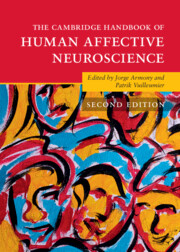Book contents
- The Cambridge Handbook of Human Affective Neuroscience
- Cambridge Handbooks in Psychology
- The Cambridge Handbook of Human Affective Neuroscience
- Copyright page
- Contents
- Figures
- Tables
- Contributors
- Introduction
- Section I Theoretical Models of Emotion
- Section II Measuring Emotional Processes
- Section III Emotion Perception and Elicitation
- Section IV Emotional Learning and Memory
- Section V Cognition–Emotion Interactions
- Chapter 19 Affective Biases in Attention, Cognitive Control, and Awareness
- Chapter 20 How Emotional Expressions Motivate Action
- Chapter 21 From Perception to Action
- Chapter 22 Neural Mechanisms of Arbitration between Multiple Experts in Value-Based Decision-Making
- Chapter 23 The Affective Neuroscience of Emotion Regulation
- Section VI Social Emotions
- Section VII Individual Differences
- Index
- References
Chapter 22 - Neural Mechanisms of Arbitration between Multiple Experts in Value-Based Decision-Making
from Section V - Cognition–Emotion Interactions
Published online by Cambridge University Press: 16 September 2025
- The Cambridge Handbook of Human Affective Neuroscience
- Cambridge Handbooks in Psychology
- The Cambridge Handbook of Human Affective Neuroscience
- Copyright page
- Contents
- Figures
- Tables
- Contributors
- Introduction
- Section I Theoretical Models of Emotion
- Section II Measuring Emotional Processes
- Section III Emotion Perception and Elicitation
- Section IV Emotional Learning and Memory
- Section V Cognition–Emotion Interactions
- Chapter 19 Affective Biases in Attention, Cognitive Control, and Awareness
- Chapter 20 How Emotional Expressions Motivate Action
- Chapter 21 From Perception to Action
- Chapter 22 Neural Mechanisms of Arbitration between Multiple Experts in Value-Based Decision-Making
- Chapter 23 The Affective Neuroscience of Emotion Regulation
- Section VI Social Emotions
- Section VII Individual Differences
- Index
- References
Summary
The brain faces an array of behavioral control challenges varying in complexity, abstraction, and temporal scale. Leveraging multiple decision-making strategies offers a clear advantage, allowing for adaptability to different contexts. Even when solving a single problem, the selection from or combination of different strategies can enhance the likelihood of success. Consequently, the brain faces the critical task of arbitrating between experts effectively. Here, we review theories of multiple controllers in value-driven decision-making, the mechanisms of arbitration between them, and the neural correlates of such processes. Although these theories have provided meaningful explanations for observed behavior and neural activity, fundamental questions persist regarding the precise nature of these controllers, their interactions, and their neural underpinnings. Notably, the role of subjective states in these computations has been largely overlooked, despite their obvious importance in the experience of making decisions.
Information
- Type
- Chapter
- Information
- The Cambridge Handbook of Human Affective Neuroscience , pp. 444 - 463Publisher: Cambridge University PressPrint publication year: 2025
References
Accessibility standard: WCAG 2.0 A
Why this information is here
This section outlines the accessibility features of this content - including support for screen readers, full keyboard navigation and high-contrast display options. This may not be relevant for you.Accessibility Information
Content Navigation
Allows you to navigate directly to chapters, sections, or non‐text items through a linked table of contents, reducing the need for extensive scrolling.
Provides an interactive index, letting you go straight to where a term or subject appears in the text without manual searching.
Reading Order & Textual Equivalents
You will encounter all content (including footnotes, captions, etc.) in a clear, sequential flow, making it easier to follow with assistive tools like screen readers.
You get concise descriptions (for images, charts, or media clips), ensuring you do not miss crucial information when visual or audio elements are not accessible.
You get more than just short alt text: you have comprehensive text equivalents, transcripts, captions, or audio descriptions for substantial non‐text content, which is especially helpful for complex visuals or multimedia.
Visual Accessibility
You benefit from high‐contrast text, which improves legibility if you have low vision or if you are reading in less‐than‐ideal lighting conditions.
Structural and Technical Features
You gain clarity from ARIA (Accessible Rich Internet Applications) roles and attributes, as they help assistive technologies interpret how each part of the content functions.
